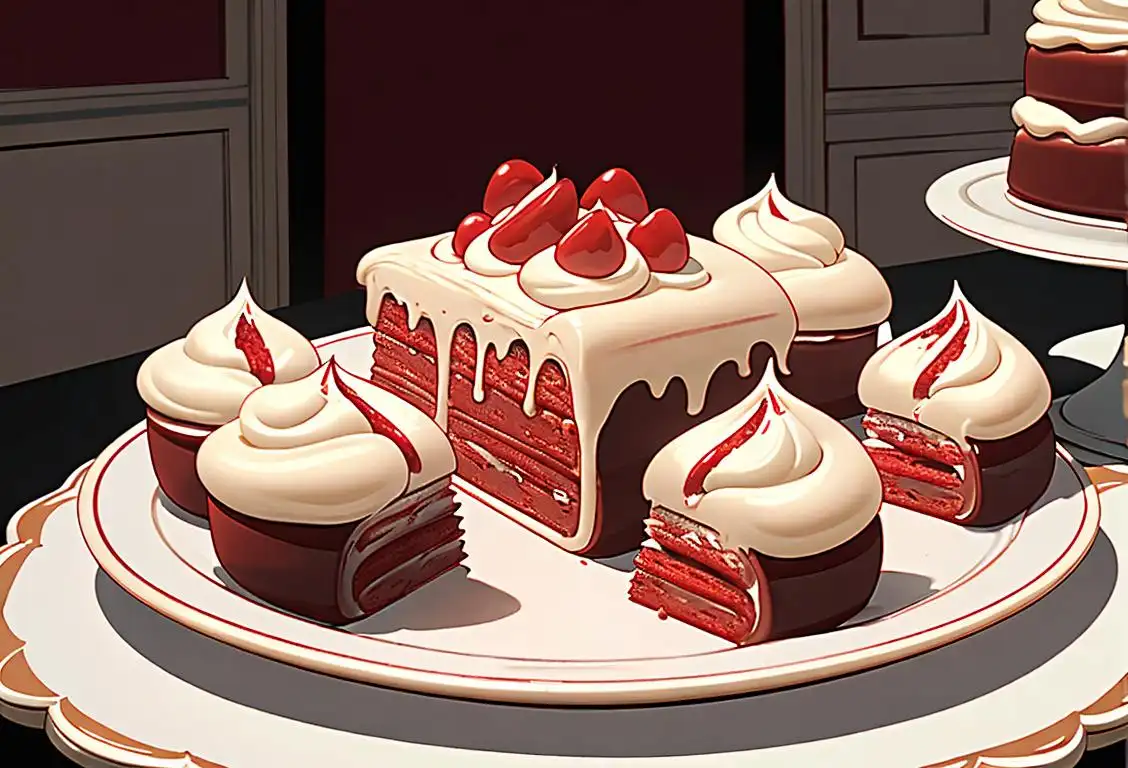National Red Velvet Cake Day

National Red Velvet Cake Day, also known as the 'Sweetest Day of the Year'- no seriously, somebody once called it that on Twitter and we've been tickled pink (or should we say, red?) ever since. It's the day where diet rules are thrown out of the window and the world unites in their love for the heavenly hybrid of chocolate and vanilla, draped in a seductively deep red hue.
When is Red Velvet Cake Day?
It's national red velvet cake day on the 18th September.
The Decadent History
The origins of the red velvet cake are as rich and velvety as the cake itself. Thought to have originated during the Victorian era, the red velvet cake got its 'red' demeanor from anthocyanin, a pigment found in cocoa that reacts to acidic ingredients, like vinegar and buttermilk, in the cake but with the Cockaigne revolution, red food coloring took centre stage and hence, the iconic red was birthed.
Let's Talk Internet
Surprisingly, there's not much evidence for National Red Velvet Cake Day predating the rise of the internet. The earliest mention we found was on 18th September 2015, with 19 occurrences until now. And since then, it's been all about sharing mouth-watering images of red-tinged slices smeared with cream cheese frosting and even adventurous red velvet-themed desserts like pancakes and cookies, turning the internet into a literal sweet shop!
How to Celebrate?
Go all out on National Red Velvet Cake Day! Bake your own red velvet cake at home, visit your favorite bakery for a fresh slice or even treat yourself (and your waistline) to a red velvet smoothie or a healthy red velvet mug cake. It's about immersing yourself in the red madness for a day and showing your solidarity to fellow red velvet cake lovers across the globe.
History behind the term 'Red Velvet Cake'
1873
The Birth of Red Velvet Cake
Red velvet cake is believed to have originated in the 19th century, with the first known recipe appearing in 1873. This rich and indulgent dessert quickly gained popularity due to its distinctive vibrant red color and velvety texture. The exact origin of the cake is unclear, but it is often associated with the American South.
1930s
Addition of Cocoa and Buttermilk
In the 1930s, red velvet cake recipes began to include cocoa powder and buttermilk. These ingredients not only intensified the cake's red color but also added a subtle chocolate flavor and moistness to the crumb. The reaction between the acidic buttermilk and cocoa creates a chemical reaction that enhances the cake's reddish hue.
1940s
Waldorf Astoria's Red Velvet Recipe
Red velvet cake gained further popularity in the 1940s when the luxurious Waldorf Astoria hotel in New York City popularized their own version of the cake. The hotel claimed their red velvet cake recipe as a closely guarded secret, and it became a sought-after dessert for their guests. The Waldorf Astoria's version accentuated the cake's red color with a rich cream cheese frosting.
1990s
Red Velvet Revival
After a few decades of relative obscurity, red velvet cake experienced a resurgence in popularity during the 1990s. Many bakeries and dessert shops began offering red velvet as a specialty item, incorporating modern twists, such as red velvet cupcakes and layer cakes. The cake's distinct appearance and indulgent flavor made it a beloved choice for special occasions and celebrations.
Present
Red Velvet Worldwide
Today, red velvet cake has become a beloved dessert worldwide. It has transcended its Southern roots and has become a staple in bakeries and restaurants across the globe. The unique combination of the vibrant red color, subtle chocolate flavor, and creamy frosting continues to captivate dessert enthusiasts. Red velvet cake is often associated with celebrations, particularly Valentine's Day and Christmas.
Did you know?
Did you know? Anthocyanin - the original source of the red color in red velvet cakes - is a powerful antioxidant that is believed to fight cancer, heart diseases and even aging. Looks like eating that slice of red velvet cake just got even better!Tagged
awareness food fun loved onesFirst identified
18th September 2015Most mentioned on
18th September 2015Total mentions
19Other days
Biscuit Day
Cheese Lovers Day
Cheese Pizza Day
Bacon Day
Agriculture Day
Pumpkin Day
Foundation Day
Medal Of Honor Day
Guac Day
Drink A Beer Day









